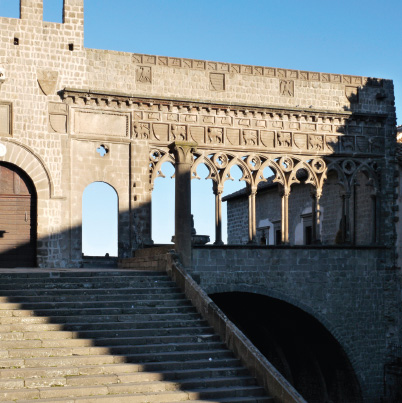![]()
VITERBO is the major city of the northern Lazio. There had been an Etruscan settlement, but the place was of little importance until it was fortified in 773; five years later it was granted by Charlemagne to the papacy. Work on the ambitious circuit of the walls, which largely survive, commenced in 1095, and in the thirteenth century Viterbo was the second capital of the popes in their long struggle with the Hohenstaufen, as we are reminded both by the Palazzo Papale and the tombs of Popes Clement IV and Adrian V, who died respectively in 1268 and 1276, in the austere Franciscan church. Thereafter the city dwindled in importance, and as a result much of its medieval core survives. By coincidence Viterbo has two links with the English royal house: in 1271 Henry, Earl of Cornwall was murdered in the church of the Gesù, and Henry VIII’s kinsman Reginald Pole was legate of the patrimony of Saint Peter (the secular governor based in Viterbo) from 1541 until 1555.

Palazzo Papale, the Loggia, 1255–66.
Cathedral from the Loggia.
The administrative centre of the city, now the Piazza del Plebiscito, is surrounded by public buildings. From its south-eastern angle the Via San Lorenzo winds upwards, crossing the partly Etruscan Ponte del Duomo and passing the early Quattrocento Palazzo Farnese, to the Piazza San Lorenzo. Ahead is the cathedral and to the north the Palazzo Papale, begun between 1255 and 1266, with an elegant open loggia overlooking the lower part of the city. The Cinquecento front of the cathedral masks a handsome twelfth-century structure, with a wide nave separated from the aisles by colonnades. On the left wall there is an altarpiece of exceptional interest, Girolamo da Cremona’s Christ and Four Saints of 1472, with a trenchant profile of the donor, Bishop Settala. We think of Girolamo as a miniaturist of genius, and in this altarpiece see that he was a key figure in the interplay of artistic ideas at a decisive moment.
Cross back over the Ponte del Duomo and make to the right for a fine early church, Santa Maria Nuova, and then cut eastwards through the atmospheric medieval quarter that preserves much of its twelfth-century character. Work round to the Fontana Grande of 1206–79. From here the Via Garibaldi runs to the Porta Romana, to the left of which is another good Romanesque church, San Sisto. Outside the gate, turn left and follow a stretch of the well-preserved walls, which now serve to protect the city from a modern enemy, traffic pollution, for some 250 metres, to Santa Maria della Verità. This suffered gravely in the war. On the right is the Gothic Cappella Maz-zatosta, justly celebrated for the remarkable cycle of frescoes of 1469 by a short-lived local master, Lorenzo da Viterbo. Although these have had to be detached and thus have lost something of their original power, we are left in no doubt that Lorenzo studied Piero della Francesca’s lost frescoes in Rome. But Lorenzo was more than a mere imitator; he had a compelling artistic integrity of his own.
Beside the church is the Museo Civico. The archaeological collection is extensive, but the pictures are of more general interest. Among those by local artists is a more than competent Nativity of 1488 by Antonio da Viterbo, the Viterbese follower of Perugino who assisted Pinturicchio in the Borgia Apartments of the Vatican. The masterpiece is Sebastiano del Piombo’s Pietà, a lapidary masterpiece which exemplifies the artist’s close association with Michelangelo.